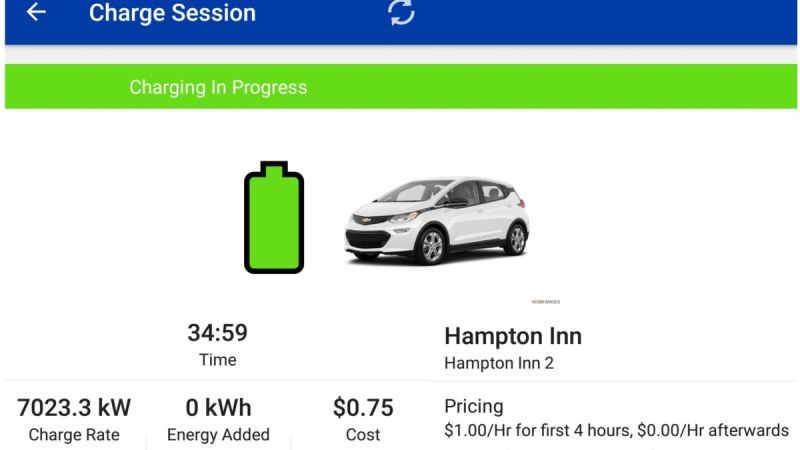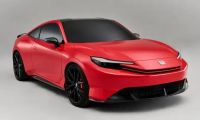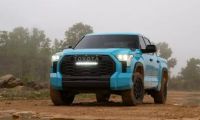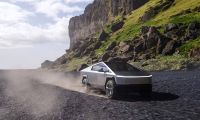As summer arrives and warm temperatures embrace much of North America, it’s the ideal time to hit the road in your EV. With several non-Tesla models now moving beyond 200 miles per charge – and in some cases much closer to 300 miles – there are more and more all-electric cars capable of traveling long distances on vacation.
Whether it’s existing models like our Chevy Bolt EV and the second-generation Nissan Leaf or new contenders like the Hyundai Kona Electric and Kia Niro EV, long-range options are growing every year.
We previously reported that EV adoption rose sharply in 2018. With many new drivers lining up to take their first summer trip in those vehicles, here are four essential tips for any (non-Tesla!) EV road trip.
4 Elements of a Successful EV Road Trip
Here are our suggestions for a successful long-range journey in a Chevy Bolt EV (or any other electric vehicle you feel has enough range for your road trip!):
1. Scout Your Route on Plugshare
Yes, every network app has its own unique benefits - and limitations - but Plugshare is currently the one charging app to rule them all. Because it leans heavily on crowdsourced listings and feedback, Plugshare has become the most comprehensive app for real-world experience of specific charging stations you might want to use.
One overlooked aspect of Plugshare is that the desktop version offers slightly different functionality to the app. As a result, the desktop version should be your go-to tool for the early planning stages on a computer, while the app is better for planning in transit and viewing recent activity.
Start by using the new ‘Trip Planner’ option to enter your origin and destination. From here, you can use the many filters to customize your trip, such as minimum location rating and local amenities like food and restrooms. Plugshare will then map your journey and show only the relevant charging locations along the route that meet your criteria.
(Don’t forget to filter out plug types that your vehicle can’t use. I haven’t done it – yet – but pulling into a CHAdeMO-only location as a Chevy Bolt EV driver running low on electrons wouldn’t be a pleasant experience!)
Click through some of the listings that look promising and read the recent check-ins from other EV drivers. If they had a good experience and the amenities you need are nearby, add that charger to your favorites or bookmark the location in your map app to add it to your travel itinerary.
Other useful sites/apps with route planning features include:
ABRP - A Better Route Planner
ChargeHub
Chargeway
Watch us hit the road on a 2,000+ mile long-range EV road trip in the video below.
2. Grab Your Apps
Having dismissed individual network apps as mere contenders to Plugshare’s crown, I’m now going to recommend you download them…or at least those from charging networks you’ve mapped out in the step above.
Why? Well, a lot of these apps have unique info and functionality that Plugshare can’t always offer, such as power level, specific directions or costs, and starting a charge from the app.
The ChargePoint app, for example, typically gives a more reliable breakdown of costs than Plugshare listings, which may become outdated if the spot isn’t regularly used. As another example, Electrify America’s new app will give you notifications about charger availability and the specific power level of each unit.
More importantly, in most networked apps you can monitor your state of charge after you plug in. If you intend to wander off to do some shopping or grab a bite to eat while you charge, this can be invaluable. Stopping a session the moment you hit 80% and the charge rate slows, for example, is one potential use that Plugshare, in most cases, can’t provide.
Watch me test the new Electrify America app in a Chevy Bolt EV and Click To Subscribe To Torque News Youtube Channel for Daily Tesla and Automotive News Analysis.
3. Add Destination Charging at Overnight Stays
Anyone who says they like to drive into the high hundreds of miles in a single day without stopping, save for one short splash and dash gas break, is a rare breed. Yes, these road warriors exist, but it’s not the way most of us want to spend our vacation.
With that in mind, you’ll probably be adding hotel or camping stops to your itinerary. This hands the advantage back to all-electric on your EV road trip, as you can often score destination charging as a complimentary or inexpensive addition to overnight stops.
Plugshare comes in handy again here, as you can filter locations on your route that are at hotels or have accommodation nearby.
This can also be a great way to seek out new destinations and explore new towns. Perhaps you’ll find a hidden gem just a little off your route, where you can spend a few hours exploring as well as waking up to a full battery. On every road trip we take in our Chevy Bolt EV, destination charging has been the secret sauce to minimizing “in transit” charging time.
On the topic of charging, fast charge speed is one of several aspects of the Chevy Bolt EV we've highlighted for improvement.
4. Add a Buffer and a Backup
The non-Tesla charging infrastructure is getting better every month, but we’re still some way from having a reliable charger around every corner. Until that time, it’s important to work a backup charging location into your primary plan and leave yourself enough range to get there.
In a Chevy Bolt EV traveling around the Northeast United States and Canada, we find 15-20 miles usually makes for a comfortable buffer. When we head to the Midwest that might stretch to 30 miles or more. It depends very much on your comfort zone and the availability of level 2 charging in the areas you visit.
Whatever your number is, be sure to have the location of your backup option plugged into your favorite map app so that it’s easily accessible in a pinch.
On the rare occasion that you do need to use your backup plan, taking the slower roads to get there is often a good way to get more miles from your battery. In our Chevy Bolt EV, the range estimator attunes itself to the most recent driving conditions, over which speed is a major factor. Slowing to 40-50mph on secondary roads after extended periods on the Interstate causes the lower range estimate to become more and more optimistic, creeping up into the green and giving you miles back as you seek out the alternative charge station.
It’s would be unrealistic to claim that EV road trips are just as quick and convenient as journeys in a gas car at this point. They still aren’t and we have several years to go before the developing infrastructure matches the future technology of electric cars.
However, all-electric road trips in non-Tesla vehicles like the Chevy Bolt EV are entirely possible and, in many ways, much more fun than a traditional journey on gasoline.
Follow the planning steps above and you’ll make it to your destination with range to spare, explore new places you might not have otherwise considered, and wake up for the next leg of driving with a fully charged EV ready to hit the road.
Also Watch 4 Reasons Why Bolt EV Owners May Convert To Tesla Model Y and Click To Subscribe to Torque News Youtube Channel for Daily EV and Automotive News.
See you in the next story for more on summer road trips in a Chevy Bolt EV.
Steve Birkett is an electric vehicle advocate at Plug & Play EV. You can follow him on Twitter at @Plugandplayev, Instagram and Youtube at Plugandplayev Channel to send him EV news tips.













Comments
A better route planner dot
Permalink
A better route planner dot com is the best source for planning a Chevy Bolt or any EV trip in terms of charging your EV.
I do like the detailed
Permalink
In reply to A better route planner dot by Matthew (not verified)
I do like the detailed settings of ABRP, but when I've tried it on routes I know well in Massachusetts and upstate New York, I often find it wants us to stop at a location I'd consider too early. On a recent trip from Boston to Cleveland, OH, for example, ABRP had us stopping on the Masspike, even though personal experience tells me we can make it through to Albany, NY area on a full charge. Appreciated the reminder though, thanks, and I've updated the article to include some alternatives.
I have 2 all-electric 2018
Permalink
I have 2 all-electric 2018 BMW EVs, both with shorter ranges than a Chevy Bolt (each about 120 miles). I never plan my trips from SoCal to NorCal or to Mexico, just open the PlugShare app & go. I meet many Bolt drivers along the 99 corridor between SoCal & NorCal- love to do just 1 charge, like a Bolt. Record is 1,343 miles in 4 driving days on a biz trip; an adventure to charge between appointments, but PlugShare app makes it easy.
I am the rare breed that
Permalink
I am the rare breed that likes to drive into the high hundreds of miles in a single day without stopping, save for one short splash and dash gas break. I have the Google maps data to prove it. I take my truck 600 miles on a tank, refill in 5 minutes and get back on the road. All that planning to look for a plug is a fool's game. No thank you.
Good for you, that sounds
Permalink
In reply to I am the rare breed that by Jonathan S Miller (not verified)
Good for you, that sounds absolutely horrendous to me but everyone has their preferences. And at this point looking for a plug is really as simple as searching a map app, which is exactly what I'd do to find a suitable restaurant or hotel, so the effort is minimal. While you're sharing travel data, do let us know what MPG your truck gets and how much it costs to fill the tank. Thanks!
My truck is paid for so I'm
Permalink
In reply to Good for you, that sounds by Steve Birkett
My truck is paid for so I'm saving g a butt ton of money not buying an EV and gas is $1.49 a gallon right now
My EV is paid for, as is my
Permalink
In reply to My truck is paid for so I'm by Jscott1000 (not verified)
My EV is paid for, as is my solar. At some time you had to pay for your truck too. I think the point is $ per mile comparison means something and is an interesting point of comparison when talking about road trips.
Also, where are you that gas is $1.50?!? I live in a pretty cheap gas state (Arizona) and we are pushing $3.00